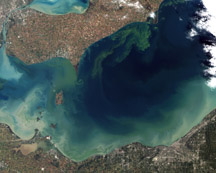Academic Research Grantmakers
Carnegie Science Venture Grants
Carnegie Science Venture grants are internal awards of up to $150,000 that are intended to foster entirely new directions of research by teams of scientists that ignore departmental boundaries. Up to three adventurous investigations may be funded each year. The period of the award is two years, with a starting date within three months of the announcement of the selected projects
___________________________
Ocean Acidification Research
Coral reefs are havens for marine biodiversity and underpin the
economies of many coastal communities. But they are very sensitive to
changes in ocean chemistry resulting from greenhouse gas emissions, as
well as to pollution, warming waters, overdevelopment, and overfishing.
Reefs use a mineral called aragonite, a naturally occurring form of
calcium carbonate, CaCO3, to make their skeletons. When carbon dioxide, CO2,
from the atmosphere is absorbed by the ocean, it forms carbonic
acid—the same stuff that makes soda fizz--making the ocean more acidic
and thus more difficult for many marine organisms to grow their shells
and skeletons and threatening coral reefs globally.
Ken Caldeira and colleagues have looked at several aspects of coral reef decline. In one study they calculated ocean chemical conditions that would occur under different future scenarios and determined that if we continue on our current emissions path, by the end of the century there will be no areas of the ocean with the chemical properties that have supported coral reef growth in the past. In another study at Australia’s Great Barrier Reef, the researchers found that carbonate accumulation is 44% lower than 40 years ago and that the reef dissolves nearly three times more at night than in the 1970s. They suspect that sea cucumbers are a factor in this nightly activity as they feed.
____________________________
Marilyn Fogel Endowed Fund for Internships
Established in June of 2016 with a generous gift of $50,000 from Marilyn Fogel and Christopher Swarth, the Marilyn Fogel Endowed Fund for Internships will provide support for “very young budding scientists” who wish to “spend a summer getting their feet wet in research for the very first time.” The income from this endowed fund will enable high school students and undergraduates to conduct mentored internships at Carnegie’s Geophysical Laboratory and Department of Terrestrial Magnetism in Washington, DC starting in the summer of 2017.
Marilyn Fogel’s thirty-three year career at Carnegie’s Geophysical Laboratory (1977-2013), followed by four years at the University of California, have been remarkably creative and highly productive. Her indefatigable spirit, extraordinary energy, training as a biogeochemist, and expertise in stable isotope chemistry has led to many breakthroughs in the fields of paleo-ecology and climate change, astrobiology, and modern ecosystem studies. She has a special talent for inspiring other scientists to step outside of their comfort zones and join her in identifying and embracing new ways of approaching and solving scientific problems.
Marilyn has an equally special talent for mentoring young scientists, be they postdoctoral fellows, graduate students, undergraduates, or high school students. She challenges them to think more creatively and broadly about science than they have ever thought before, providing them with the respect, attention and support that transform them in ways they could never have anticipated.
It is in this spirit that we are asking all of those whose lives have been touched by Marilyn to make a contribution in support of this endowed fund. By supporting this fund, you will help perpetuate the mentoring of talented young people who will someday, following in Marilyn’s capacious footsteps, take daring leaps into new ways of doing science.
___________________________
Anna Michalak’s team combined sampling and satellite-based observations of Lake Erie with computer simulations and determined that the 2011 record-breaking algal bloom in the lake was triggered by long-term agricultural practices coupled with extreme precipitation, followed by weak lake circulation and warm temperatures. The bloom began in the western region in mid-July and covered an area of 230 square miles (600 km2). At its peak in October, the bloom had expanded to over 1930 square miles (5000 km2). Its peak intensity was over 3 times greater than any other bloom on record. The scientists predicted that, unless agricultural policies change, the lake will continue to experience extreme blooms. The bloom remerged in 2014 with a vengeance, and released toxins causing problems with the drinking water in Toledo, Ohio.
___________________________
resources:
https://carnegiescience.edu/CSVgrants





No comments:
Post a Comment